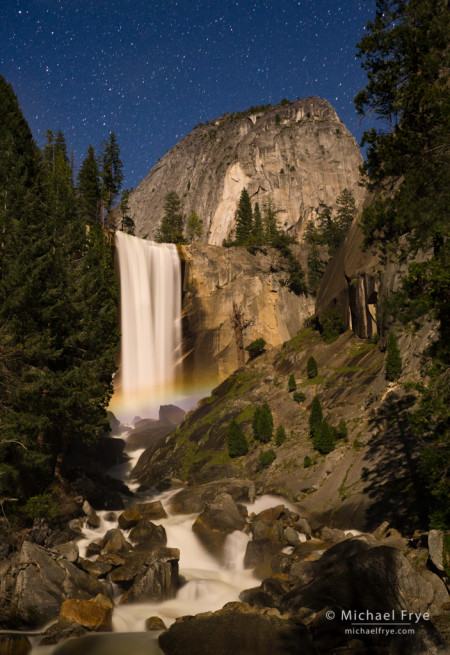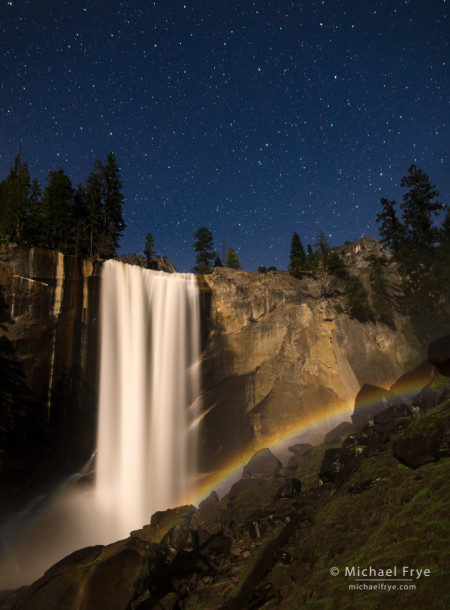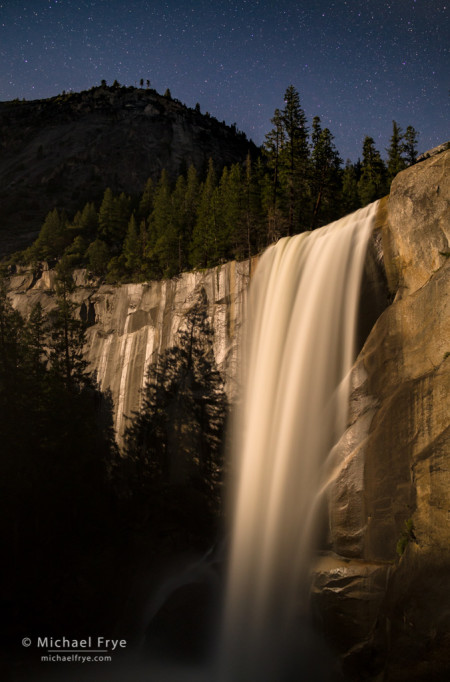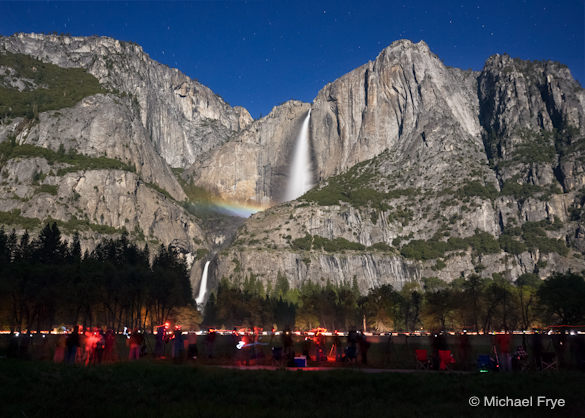Claudia and I made a nighttime trip up the Mist Trail recently. The ostensible purpose of this hike was to look for lunar rainbows, and we did find some, as you can see from the photos. But that was just a bonus. The real reward was being up there on a beautiful, moonlit night, with the roar of the falling water filling our ears, and having this normally-crowded trail completely to ourselves. It was so much fun.
The moon will be full on Thursday night, and with the good water flow this spring I expect that many photographers will be making their way to Yosemite to photograph lunar rainbows on Yosemite Falls. Don Olson has posted lunar rainbow predictions for Lower Yosemite Fall, but the spray will be soaking the bridge below the lower fall, making it hard to keep lenses dry during long exposures. Unfortunately Don hasn’t posted any predictions yet for Upper Yosemite Fall, and my trigonometry skills aren’t good enough to make those predictions myself. I think lunar rainbows will be visible on the upper fall from Cook’s Meadow at some point on Thursday evening, and the following couple of nights, but I can’t be positive!
While Yosemite Falls has become a well-known for lunar rainbows, you should be able to see lunar rainbows on almost any waterfall that gets lit by the moon and is big enough to generate spray. The only reason lunar rainbows aren’t seen very often is because people don’t usually view waterfalls at night, and don’t know what to look for.
To see a rainbow, the light source (sun or moon) has to be at your back when looking at rain or a source of spray. A rainbow forms a circle around a point opposite the light source. That circle is 42 degrees out from the anti-solar or anti-lunar point. So to find a rainbow on a waterfall you have to stand in a spot where that 42-degree circle intersects the waterfall’s spray, which is usually above and to the side of the anti-solar or anti-lunar point. Figuring out precisely when and where this will happen is actually quite complicated, but if you stand close to some spray with the sun or moon at your back you have a good chance of seeing a rainbow. Of course you can’t see color at night, so a rainbow will look like a white arc. The arc will be distinct and unmistakeable if there’s a lot of spray and the moon is bright. Film and digital sensors can record the color, so if you have any doubt about whether you’re looking at a rainbow or not you can always take a picture. (You’ll find tips on photographing lunar rainbows here.)
South-facing waterfalls get the most moonlight, but there should be times when east- or west-facing waterfalls get hit by moonlight also. And you could even see a lunar rainbow on a north-facing waterfall at certain times if you can stand at the lip of the fall and look down on the spray.
So you don’t have to come to Yosemite to see or photograph a lunar rainbow. There must be thousands of waterfalls where lunar rainbows can be seen. When I Googled “lunar rainbow” most of the images that popped up were from Victoria Falls. Viewing lunar rainbows must be a thing there, like in Yosemite.
And for that matter, you don’t even need a waterfall. Any source of spray will do. I photographed a lunar rainbow on Castle Geyser in Yellowstone many years ago. I’ve seen photos of lunar rainbows from actual falling rain. That would be fun to see! I bet you could set up a water sprinkler on a moonlight night and see a lunar rainbow in your backyard.
Comments of any kind are always welcome, but I’d be especially curious to hear from readers who have seen or photographed lunar rainbows in other places besides Yosemite. Let me know!
— Michael Frye
Related Posts: Tips for Photographing Lunar Rainbows; Lunar Rainbow Images, and the Upcoming Annular Eclipse
Did you like this article? Click here to subscribe to this blog and get every new post delivered right to your inbox!
Michael Frye is a professional photographer specializing in landscapes and nature. He is the author or principal photographer of The Photographer’s Guide to Yosemite, Yosemite Meditations, Yosemite Meditations for Women, Yosemite Meditations for Adventurers, and Digital Landscape Photography: In the Footsteps of Ansel Adams and the Great Masters. He has also written three eBooks: Light & Land: Landscapes in the Digital Darkroom, Exposure for Outdoor Photography, and Landscapes in Lightroom: The Essential Step-by-Step Guide. Michael has written numerous magazine articles on the art and technique of photography, and his images have been published in over thirty countries around the world. Michael has lived either in or near Yosemite National Park since 1983, currently residing just outside the park in Mariposa, California.













Michael,
Thanks once again for the great photos, and for sharing your extensive knowledge about photography!
Cheers,
Alyn
You’re welcome Alyn – thanks!
Are prints of the April 16 Mist Trail available
thank you
Ray Oliver
Ray, most of the images on this site are available as prints. I’ll send you an email with a list of available sizes and prices.
Michael,
Thanks so much for the lunar rainbow info and the awesome photo!!
Don Mowrer
You’re welcome Don – and thanks!
Great article and accompanying night photos of the lunar rainbows.
Thank you Mimi!
I’m heading to Yosemite later this month and wondering what lens you might recommend for me to use with my old Nikon D200?
Any help is much appreciated!
~Katie
Katie, this is what I tell workshop students:
At a minimum you should have a wide-angle lens (24mm or wider for full-frame sensors; 16mm or wider for APS-size sensors), a normal lens, and a short telephoto (at least 90mm long for full-frame sensors; 60mm or longer for APS-size sensors), or zooms that cover that range. If you also have longer and shorter focal lengths that’s even better; ideally you’d like to cover the range from 17mm to 200mm for a full-frame sensor, or 12mm to 135mm for an APS-size sensor.